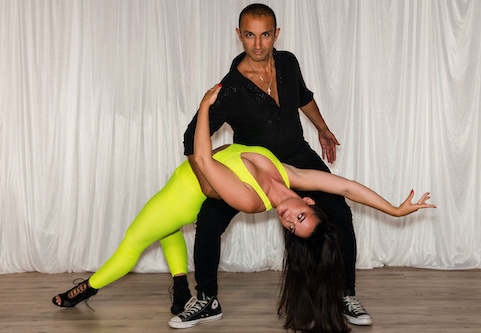The Definitive Guide for Dance Fridays
Wiki Article
Not known Factual Statements About Dance Fridays
Table of ContentsThe smart Trick of Dance Fridays That Nobody is DiscussingFascination About Dance FridaysDance Fridays - The FactsFascination About Dance Fridays
Let's think about Salsa dance and songs as a huge Tree that looks like this: Salsa is danced globally while many technical elements of the dance are the same throughout designs (6 steps over 8 beats danced on a quick-quick-slow or slow-quick-quick rhythm), there are numerous "hallmark" functions of the major styles of Salsa that identify one from the various other.Pairs participating in a Gambling enterprise Rueda dance all relocate unison as called by a Leader. Distinguishing attributes of Cuban style salsa are round turn patterns (with "break back" actions on matters 1 and 5) along with body language influenced by conventional Afro-Cuban folkloric dances. Distinct features of Cali design salsa fasts and elaborate footwork, danced with a solid hand hold connection between companions.
The origins of the design are a subject of discussion, but it is claimed that New York style Salsa dance originated in the 1960's as a result of the influx of Latin American emigrants after the Cuban Revolution. Eddie Torres is the most well understood New York design dancer, being nearly globally attributed with popularizing the style to dance centres beyond New York.
The basic rhythm of "On-2" is slow-quick-quick. The "youngest" of the styles of Salsa, L.A. Style (some individuals have actually called it "West Coastline" style) ended up being prominent in the 1990's and has its beginnings in ballroom (Mambo, Swing and Cha, Cha, Cha). Turn patterns lead and comply with techniques are heavily affected by these styles, with the Cross Body Lead being the foundation of the style.
An Unbiased View of Dance Fridays
Design are execution of turn patterns and numbers in the "slot", with the break actions on counts "1" and "5". While Salsa music has strong origins in Cuban, Colombian and Puerto-Rican folkoric traditions, it can not be discounted that all Afro-Latin and Latin American societies have added to modern Salsa songs as we understand it today.It's possible that because of political factors the contribution of Afro-Cuban culture and heritage to modern Salsa in the 1960's and 70's is not widely identified, but it can not be neglected the huge contribution and influence of the "Queen of Salsa", Celia Cruz. A household name in Cuba and the Central Americas as a singer in the 1950's, Celia left Cuba for the U.S

Today Salsa music is produced, carried out and popular world-wide. In 2000 the influence of Latin American songs and society (not simply Salsa) was acknowledged by the National Academy of Recording Arts and Sciences in the United State and the Latin Grammy Honors were developed. The Latin Grammy's have brought attention to the Salsa Legends and contemporary Salsa artists alike
Dance Fridays - An Overview
differentiating characteristics of Salsa songs are: 4/4 time trademark, Son Clave and Tumbao rhythms, Montuno Piano Unless you have a history in songs, the above 3 qualities probably indicate absolutely nothing to you. A less complicated means to explain Salsa music is exactly how it does NOT seem like other sorts of Latin American prominent songs.Bachata is a straight 4 beat dance with a frequency of a syncopated guitara line and a clear absence of any "tough" piano, brass (trumpet, trombone) lines. Cha, Cha, Cha resembles Salsa songs the most as it really feels like "really slow-moving" salsa/mambo. salsa club san francisco. Cha, Cha, Cha can be distinguished by it's emphasis of the double tumbao beat on matters 4 +5 and 8 +1 (the "cha-cha-cha") You have actually been to a Salsa night at a club and you're connected you enjoy the music, the energy, the appearance of two professional dancers gliding across the dance flooring carrying out trendy rotates and transform patterns
It's time for lessons. With many workshops available and different styles to select from, where does a total rookie begin? Many brand-new professional dancers choose to learn L.A. "On-1" design slotted Salsa styles are the most widespread in The United States and Canada (with some exemptions of some city centres that still predominantly accept Cuban and Puerto Rican styles) and L (https://salsacrazysf1.weebly.com/).A
.A. Design will promptly show you the basics of Salsa timing, weight transfer and turn pattern execution. Numerous professional dancers, when they have actually had a year or two of dancing L.A. Design Salsa under their belts, "button" to New York style in order to diversify their dancing vocabulary; but several professional dancers decide to stay with simply one design of Salsa and appreciate their time on the dancing floor in that particular design (salsa club san francisco).
Design and New York Design all being danced in the exact same club, with a number of the professional dancers being able to change from one design to the various other from one track to the next. No matter which style you select it's essential to stick to that design until you're extremely page comfortable with the basics of timing, body rhythm and foundation relocation execution prior to taking into consideration "switching" styles (if you want to).

Report this wiki page